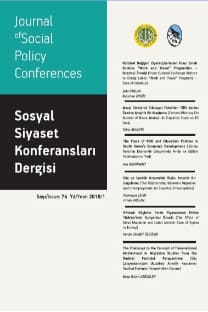DUYGUSAL EMEĞİN İŞ MEMNUNİYETİNE ETKİSİ: ÇAĞRI MERKEZİ ÇALIŞANLARINA YÖNELİK BİR ÇALIŞMA
Bu çalışmanın amacı, çağrı merkezi çalışanları tarafından sergilenen duygusal emeğin iş memnuniyeti üzerindeki etkisini incelemektir. Bu amaçla iki çağrı merkezi şirketinde çalışan 146 kişiye internet yoluyla duygusal emek ve iş memnuniyeti ölçekleri uygulanmıştır. Elde edilen bulgular çalışanların işlerini yaparken sergilemeleri gereken duygular ile gerçekte hissettikleri duygular arasında uyumsuzluk olduğunda iş memnuniyetlerinin azaldığını ortaya koymaktadır.
Anahtar Kelimeler:
Duygusal Emek, Çağrı Merkezi, İş Memnuniyeti
___
- Abraham, R. (1998). “Emotional Dissonance in Organizations: Antecedents, Consequences, and Moderators” Genetic, Social and General Psychology Monographs, 124/2, 229–246. Abraham, R. (1999). “The Impact of Emotional Dissonance on Organizational Commitment and Intention to Turnover”. The Journal of Psychology, 133/4, 441–455.
- Ashforth, B. & Humphrey, R. of Identity”. Academy of Management Review, 18, Bain, P., Watson, A., Mulvey, G., Taylor, P. & Gall, G.
- Brotheridge, C. M. & Taylor, I. Flight Attendants”. Research on Emotion in Organizations, 2, 171–196. Chu, K. H. &
- Murrmann, S. K. Emotional Labor Scale”. Tourism Management, 27, 1181–1191. Ekman, P. (1973). Darwin and Facial Expression: A Century of Research in Review. New York: Academic Press.
- Grandey, A. A. (2003). “When “the Show Must Go On”: Surface Acting and Deep Acting As Determinants of Emotional Exhaustion and Peer–Rated Service Delivery”. Academy of Management Journal, 46/1, 86–96. Gray, B. (2009). “The Emotional Labour of Nursing–Defining and Managing Emotions in Nursing Work”. Nurse Education Today, 29, 168–175.
- Hackman, J. R., & Oldham, G. R. Journal of Applied Psychology, 60, 159–170.
- Hackman, J. R., & Oldham, G. R. of A Theory”. Organizational Behavior and Human Performance, 16, 250–279. Harris, L.C. (2002). “The Emotional Labour of Barristers: An Exploration of Emotional Labour by Status Professionals”. Journal of Management Studies, 39/4, 553–584. Hochschild A. (2003). The Managed Heart: Commercialization of Human Feeling. Berkeley, Ca: University of California Press. Holman, D., Chissick, C. &
- Totterdell, P. Motivation and Emotion, 26/1, 57–81.
- Isenbarger, L. & Zembylas, M. Teaching and Teacher Education, 22, 120–134. Judge, T. A., Parker, S.,
- Colbert, A. E., Heller, D. & Ilies, R. 25–53. Judge, T. A.,
- Woolf, E. F. & Hurst, C. Study”. Personnel Psychology, 62, 57–88. Karasek, R. (1979). “Job Demands, Job Decision Latitude, and Mental Strain: Implications for Job Redsign”. Administrative Science Quarterly, 24, 285–308. Keser, A. (2006). “Çağrı Merkezi Çalışanlarında İş Yükü Düzeyi ile İş Doyumu İlişkisinin Araştırılması”. Kocaeli Üniversitesi Sosyal Bilimler Enstitüsü Dergisi, 11/1, 100–119.
- Kruml, S. M. & Gedddes, D. The Heart of Hochschild’s Work”. Management Communication Quarterly, 14/1, 8–49.
- Larson, E. B. & Yao, X. Patient–Physician Relationship”. The Journal of the American Medical Association, 293/9, 1100–1106. Lewig, K. A. &
- Dollard, M. F. and Job Satisfaction in Call Centre Workers”. European Journal of Work and Organizational Psychology, 12/4, Locke, E. A. (1969). “What is job satisfaction?”. Organizational Behavior and Human Performance, 4, 309–336.
- Morris J. A. & Feldman D. C. Consequences of Emotional Labor”. Academy of Management Review, 21, 986–1010.
- Morris, J. A., & (1997). “Managing Emotions in The Workplace”.
- Feldman, D. C. Journal of Managerial Issues, 9(3), 257–274.
- Mulholland, K. (2002). “Gender, Emotional Labor, Teamworking in A Call center”. Personel Review, 31/3, 283–303. OECD (2008). OECD In Figures 2008. Fransa: OECD Publications. Öz, Ü. E. (2007). Duygusal Emek Davranışlarının Çalışanların İş Sonuçlarına Etkisi. İstanbul: Beta Yayınları. Parlak, Z. &
- Işıl Çetin, B. Merkezleri: Emek Süreci, İş ve İstihdam”. Sosyal Siyaset Konferansları, 52, 107–134.
- Selek Öz, C. & Man, F. Merkezi Çalışanlarının Duygusal Emek Süreçleri. 15. Yönetim ve Organizasyon Kongresi. 25–27 Mayıs, Sakarya Üniversitesi, Kartepe. Seymour, D. (2000). “Emotional Labour: A Comparison Between Fast Food and Traditional Service Work”. Hospitality Management, 19, 159–171.
- Schaubroeck, J. & Jones, J. Dimensions and Moderators of Their Effects on Physical Symptoms”. Journal of Organizational Behavior, 21, 163–183. Taylor, P. & Bain, P. Employee Relations in the Call Centre”. Industrial Relations Journal, 30/2, 101–117.
- Wharton, A. S. (1999). “The Psychological Consequences of Emotional Labour”. The Annals of The American Academy of Political and Social Science, 561,158–176. Yang, F. & Chang, C. Organizational Commitment Amongst Clinical Nurses: A Questionnaire Survey”. International Journal of Nursing Studies, 45, 879–887. Zapf, D., Isic, A.,
- Bechtoldt, M. & Blau, P. Organizational Psychology, 12/4, 311–340. Zapf, D. (2002). “Emotion Work and Psychological Well–Being A Review of the Literature and Some Conceptual Considerations”. Human Resource Management Review, 12, 237–268. Zapf, D., Vogt, C., Seifert, C.,
- Mertini, H., & Isic, A. Zhang, Q. & Zhu, W. Labor, Burnout, and Satisfaction in Chinese Higher Education”. Communication Education, 57/1, 105–122.
- ISSN: 1304-0103
- Yayın Aralığı: Yılda 2 Sayı
- Başlangıç: 1948
- Yayıncı: İstanbul Üniversitesi Yayınevi
Sayıdaki Diğer Makaleler
OSMANLI DEVLETİ'NDE ERMENİ KÖKENLİ BİR BÜROKRAT: AGOP KAZAZYAN
TÜRKİYE'DE AKTİF SİGORTALI SAYISINI BELİRLEYEN FAKTÖRLER
ÇAĞDAŞ TÜRK TOPLUMLARINDA AİLE VE EVLİLİK İLİŞKİLERİ
ÇALIŞMA ÜZERİNE SOSYOLOJİK PERSPEKTİF
YEREL YÖNETİMLERDE SOSYAL POLİTİKA VE SOSYAL HİZMETLER: LONDRA BARNET BELEDİYESİ ÖRNEĞİ
GENÇ İŞSİZLİĞİN TEORİK AÇIKLAMALARI
ÇALIŞMANIN SOSYOLOJİK VE TEKNİK YÖNLERİ ÜZERİNE BİR İNCELEME
DUYGUSAL EMEĞİN İŞ MEMNUNİYETİNE ETKİSİ: ÇAĞRI MERKEZİ ÇALIŞANLARINA YÖNELİK BİR ÇALIŞMA
DOKTOR GRUPLARINDA EKONOMİ EĞİTİMİNİN GENEL ÖZELLEŞTİRME UYGULAMALARINA BAKIŞ ÜZERİNDEKİ ETKİSİ
